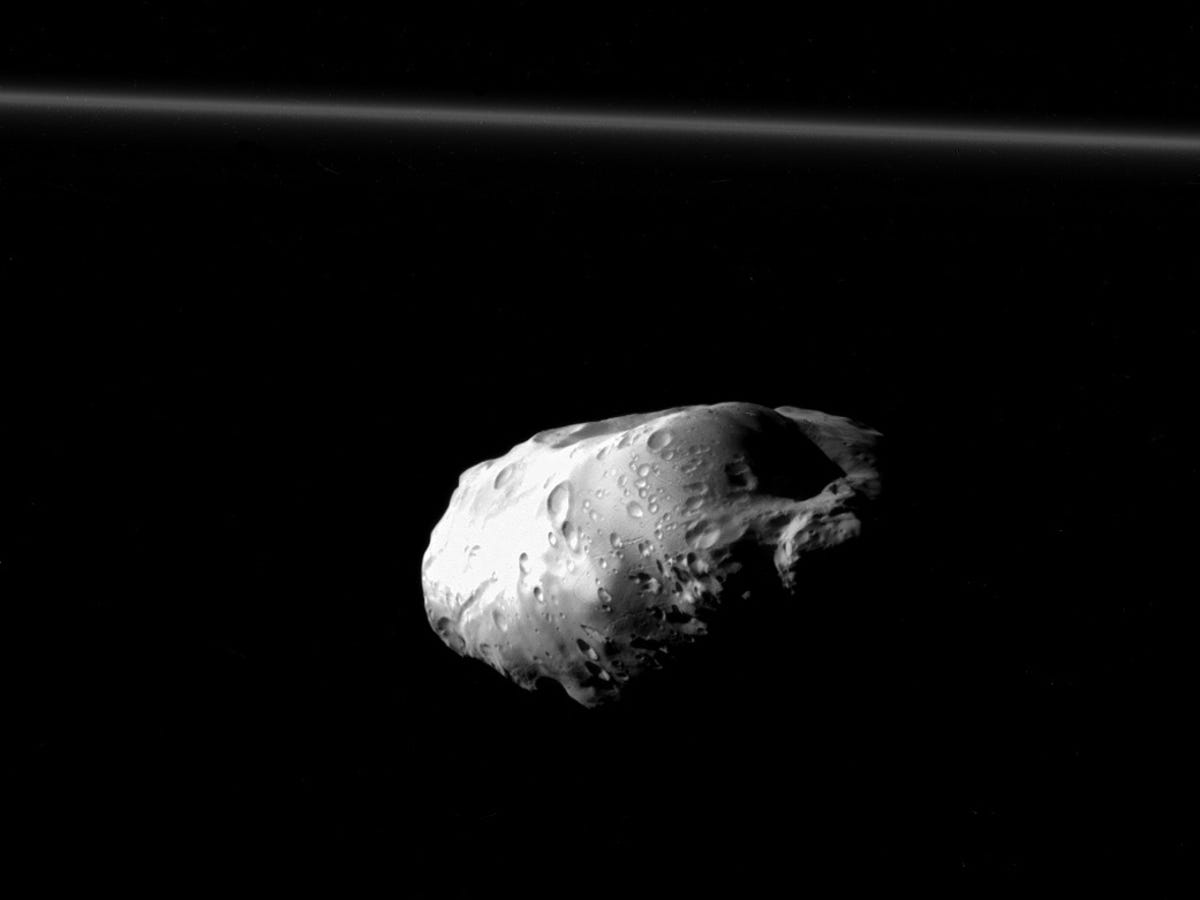NASA shoots for Saturn's moons with dazzling Cassini views (pictures)
Saturn has over 50 named moons and NASA's Cassini spacecraft is busy frolicking among them, sending back eye-catching images of these far-off celestial bodies.

Prometheus, Saturn's 'potato' moon
NASA's Cassini spacecraft has been hanging out around Saturn since 2004. That's plenty of time to check out the ringed planet's many moons, which range from the fascinating bulky sphere of Titan to some tiny moons that are less than 20 miles across.
Prometheus is a bit of an odd duck. It's not round, but rather has an oblong shape that looks quite a bit like a space potato. The moon's cratered surface really makes it look like you could wrap it in foil and throw it in the oven. Cassini took this image of Prometheus during a flyby on December 6.
Saturn and Titan together
NASA's Cassini spacecraft captured this image of the moon Titan in front of the hulking shape of Saturn. They both appear cloudy, but NASA points out some extreme differences between the two celestial bodies. "Saturn is a gas giant with no solid surface to speak of. Titan's atmosphere is a blanket surrounding an icy, solid body," the space agency says.
Cassini's close look at Dione
Cassini turns its eyes to Saturn's moon Dione earlier this year and caught some up close and personal images of the icy object in orbit around the ringed planet. This gorgeous full view came from a close flyby in August when Cassini zipped by at just 295 miles (474 kilometers) from Dione's surface.
"I am moved, as I know everyone else is, looking at these exquisite images of Dione's surface and crescent, and knowing that they are the last we will see of this far-off world for a very long time to come," said Carolyn Porco, Cassini imaging team lead.
Hyperion looks like a sponge
Not all of Saturn's moons look like perfect round spheres in space. Not only does Prometheus look a lot like a potato, the moon in this picture, Hyperion, could pass for a bath sponge. Hyperion has an average diameter of 168 miles (270 kilometers) and is the ringed planet's largest irregularly shaped moon, according to NASA.
Three moons rising
Saturn has over 60 moons, but it can be hard to catch multiple moons together in a single image. This Cassini shot from 2014 shows Tethys, Hyperion and Prometheus together with Saturn's rings in one frame. Tethys is the large bright moon in the center. Hyperion is in the upper left and small, potato-like Prometheus peeks out from beneath the rings to the lower left.
Beneath Titan's haze
A composite infrared image shows what Saturn's fascinating moon Titan looks like underneath its atmospheric haze. The images and data used to create this view came from a Cassini mission flyby in November. "The view looks toward terrain that is mostly on the Saturn-facing hemisphere of Titan. The scene features the parallel, dark, dune-filled regions named Fensal (to the north) and Aztlan (to the south), which form the shape of a sideways letter 'H'," NASA notes.
Triple crescent moons
A crescent moon can be a beautiful sight on Earth. If you think a single moon is lovely, then enjoy this Cassini image of three crescent moons together in space around Saturn. Titan, Rhea and Mimas are all on display here. Titan is Saturn's largest moon while Mimas is quite small.
Two very different moons
Saturn's more than 60 moons represent an incredibly diverse bunch of space objects. Some of those differences are on display in this Cassini image showing Dione in the foreground and Enceladus behind. Enceladus is bright and icy with "a constant rain of ice grains from its south polar jets." Dione's surface is older and marked with dust and radiation damage.
Close-up on Dione
Saturn's moon Dione was a top focus of NASA's Cassini mission during 2015. The small moon is just 698 miles (1,123 kilometers) in diameter and sports a craggy, cratered surface. The white line extending from the top is part of Saturn's rings. This image was taken during a series of close flybys of the moon.
Bull's eye in the sky
Enceladus and Tethys, two of Saturn's moons, line up in perfect fashion for this Cassini image that NASA describes as a "cosmic bull's eye." Enceladus is the closer of the two moons and the way they line up gives a good idea of their relative sizes. Tethys is about twice the diameter of icy Enceladus.
Titan's massive ice cloud
Saturn's largest moon Titan is a mysterious place. It has a disappearing and reappearing island. NASA's Cassini mission sent back evidence of "a monstrous new cloud of frozen compounds in the moon's low- to mid-stratosphere" in November. Cassini has already witnessed the move from fall to winter on Titan. According to NASA, each season on Titan lasts about 7.5 Earth years. Winter is coming and it's not leaving anytime soon.
Epimetheus in the spotlight
If you need a quick Greek mythology refresher: Epimetheus was Prometheus's brother, both of whom were Titans, a group of giant deities. Many of Saturn's moons take their name from mythology. Despite its name, Epimetheus is a fairly small moon at just 72 miles (116 kilometers) across. This Cassini image from December shows its slightly irregular shape and pockmarked surface.
A very tiny moon
Saturn has a ton of moons ranging from huge to absolutely tiny. Titan dwarfs them all with a diameter of about 3,200 miles (5,150 kilometers). On the other end of the spectrum is Atlas, a miniscule moon that is a mere 19 miles (30 kilometers) across. Cassini took this image in December from a distance of about 20,000 miles (32,000 kilometers). One of Saturn's rings is seen at the bottom of the picture.

